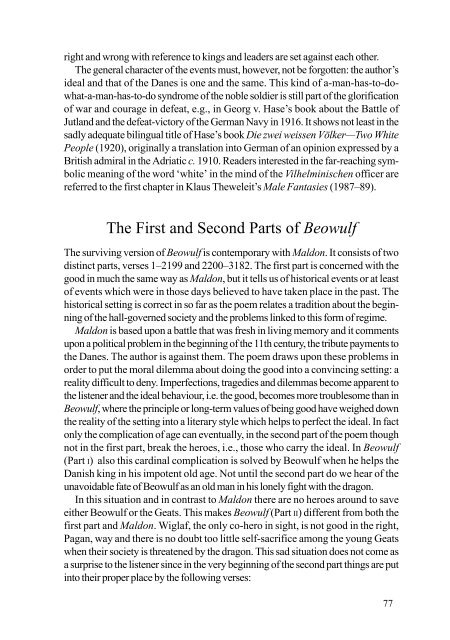Beowulf - Institutionen för arkeologi och antik historia
Beowulf - Institutionen för arkeologi och antik historia
Beowulf - Institutionen för arkeologi och antik historia
Create successful ePaper yourself
Turn your PDF publications into a flip-book with our unique Google optimized e-Paper software.
ight and wrong with reference to kings and leaders are set against each other.<br />
The general character of the events must, however, not be forgotten: the author’s<br />
ideal and that of the Danes is one and the same. This kind of a-man-has-to-dowhat-a-man-has-to-do<br />
syndrome of the noble soldier is still part of the glorification<br />
of war and courage in defeat, e.g., in Georg v. Hase’s book about the Battle of<br />
Jutland and the defeat-victory of the German Navy in 1916. It shows not least in the<br />
sadly adequate bilingual title of Hase’s book Die zwei weissen Völker—Two White<br />
People (1920), originally a translation into German of an opinion expressed by a<br />
British admiral in the Adriatic c. 1910. Readers interested in the far-reaching symbolic<br />
meaning of the word ‘white’ in the mind of the Vilhelminischen officer are<br />
referred to the first chapter in Klaus Theweleit’s Male Fantasies (1987–89).<br />
The First and Second Parts of <strong>Beowulf</strong><br />
The surviving version of <strong>Beowulf</strong> is contemporary with Maldon. It consists of two<br />
distinct parts, verses 1–2199 and 2200–3182. The first part is concerned with the<br />
good in much the same way as Maldon, but it tells us of historical events or at least<br />
of events which were in those days believed to have taken place in the past. The<br />
historical setting is correct in so far as the poem relates a tradition about the beginning<br />
of the hall-governed society and the problems linked to this form of regime.<br />
Maldon is based upon a battle that was fresh in living memory and it comments<br />
upon a political problem in the beginning of the 11th century, the tribute payments to<br />
the Danes. The author is against them. The poem draws upon these problems in<br />
order to put the moral dilemma about doing the good into a convincing setting: a<br />
reality difficult to deny. Imperfections, tragedies and dilemmas become apparent to<br />
the listener and the ideal behaviour, i.e. the good, becomes more troublesome than in<br />
<strong>Beowulf</strong>, where the principle or long-term values of being good have weighed down<br />
the reality of the setting into a literary style which helps to perfect the ideal. In fact<br />
only the complication of age can eventually, in the second part of the poem though<br />
not in the first part, break the heroes, i.e., those who carry the ideal. In <strong>Beowulf</strong><br />
(Part I) also this cardinal complication is solved by <strong>Beowulf</strong> when he helps the<br />
Danish king in his impotent old age. Not until the second part do we hear of the<br />
unavoidable fate of <strong>Beowulf</strong> as an old man in his lonely fight with the dragon.<br />
In this situation and in contrast to Maldon there are no heroes around to save<br />
either <strong>Beowulf</strong> or the Geats. This makes <strong>Beowulf</strong> (Part II) different from both the<br />
first part and Maldon. Wiglaf, the only co-hero in sight, is not good in the right,<br />
Pagan, way and there is no doubt too little self-sacrifice among the young Geats<br />
when their society is threatened by the dragon. This sad situation does not come as<br />
a surprise to the listener since in the very beginning of the second part things are put<br />
into their proper place by the following verses:<br />
77








